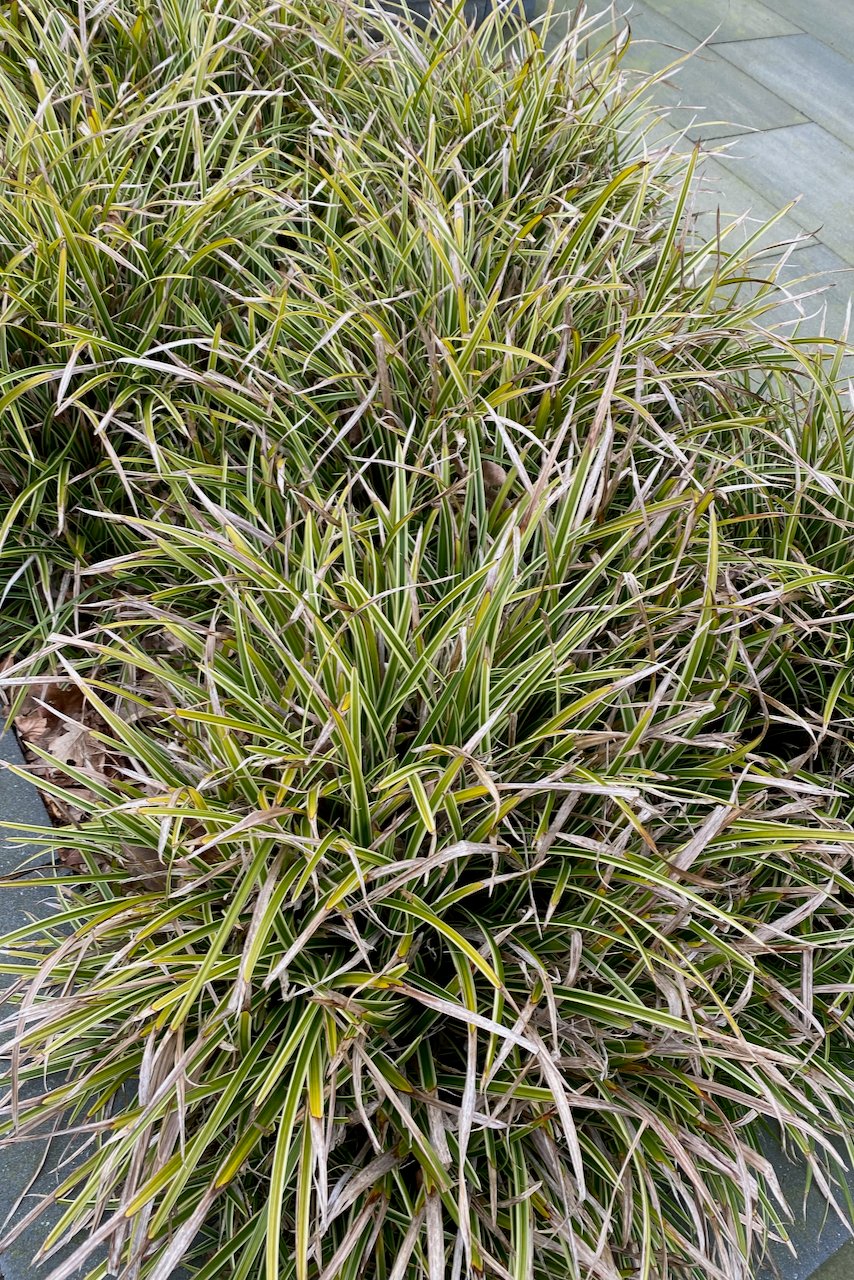
Are you growing ornamental grasses in your garden? If you are, congrats! You have officially elevated your gardening game to a whole new level.
For the longest time, I didn’t quite get the purpose of planting tall grasses when all I wanted to grow were colorful perennials and shrubs.
It only clicked when I was walking along the New York City High Line, the most impressive piece of reclaimed garden I’ve ever seen. It’s planted on a disused train track floating about 30 feet above the streets of the city, and it is spectacular.

I was visiting the week between Christmas and New Year’s Eve, so I didn’t think there would be much to see in this public garden. Oh, how wrong I was! Sure, the perennials had retreated back underground for the winter, but the garden was not bare.
It had transformed into a flawless symphony of texture and motion, owing to the various ornamental grasses swaying in the breeze. It was as if a meadow and a prairie had merged in the middle of a hectic city.
That was the moment I realized that ornamental grasses belong in any and every type of garden.
And that they should absolutely not be pruned in winter.
There, I said it!
Here’s why we shouldn’t prune ornamental grasses before spring
If you’re reading this article in spring, chances are you’ve already overwintered your grasses in place in your garden. Great job! We’re on the same page.
If you’re used to pruning ornamental grasses in the fall, let me make a case for why you should always wait until spring to do it.
1. The winter texture is part of their appeal.
Ornamental grasses are meant to be ornamental in all seasons.
Including winter.

Have a look at this absolutely gorgeous miscanthus in mid-February. It is one of the few sources of color (a warm shade that makes me think of the summer sun) in the garden throughout the cold gray months. It simply makes the garden look like it’s dancing in the wind instead of looking bare and desolate.
2. Wildlife is making good use of grasses in winter.
Depending on where you’re gardening, every part of the ornamental grass comes in handy over the winter months.

Seed heads can turn into a source of food for wildlife when there’s not much else to feed on. And small critters can use the tall grasses as a hibernation station or for bedding and nest-building.
3. It’s better for the plants themselves to overwinter in the garden.
If we prune ornamental grasses too early in the fall, warmer temperatures may trigger new growth later in the season. All this growth is pointless before winter; the energy that goes into it is wasted.

Similarly, the mass of dry husk helps insulate the crown of the plant against temperature fluctuations over the cold months.
Should we prune ornamental grasses in spring?
Yes and no!
Yes, we should prune deciduous grasses.
No, we shouldn’t prune evergreen grasses.
Here’s a bit of a recap into what that means.
1. Evergreen grasses – they don’t need pruning.
I’m starting with evergreen grasses because the instructions for them are as easy as: you don’t need to do much.
The most popular evergreen ornamental grasses are technically not true grasses, although they very much look like them.

Sedges, sometimes called Carex because they belong to this genus, make excellent garden plants because they handle great variations in temperature and humidity.
Their evergreen foliage is resistant to deer and rabbit munching. And because sedges originate from a variety of climates, they are adaptable to a variety of conditions, from full sun to shade and from low-moisture to high-moisture gardens.

A few commonly grown evergreen grasses (or ever-blue or ever-yellow) commonly used in landscaping include:
- Blue oat grass (Helictotrichon sempervirens)
- Blue fescue (Festuca glauca)
- White-tinged sedge (Carex albicanis)
- Rosy sedge (Carex rosea)
- Common sedge (Carex blanda)
- Remote sedge (Carex remota)
- Woodland sedge (Carex sprengelii)
- Bronze-leaved sedge (Carex comans ‘Bronze Form’)
- Red rooster sedge (Carex buchananii)
- Gossamer grass (Anemanthele lessoniana)
Do we need to prune sedges in the spring?
No, we don’t. Sedges – which I’ve included as a no-mow alternative to a grass lawn in this article – form evergreen clumps. Over the years, the clumps thicken, but they usually don’t spread very fast.
And since they stay green in every season, there’s no need to cut them down to rejuvenate them in spring. In fact, if we repeatedly hard-prune evergreen grasses, we may end up killing them altogether.

There may be some sedges that develop brown tips. All we have to do is trim those tips if we find them unsightly. But this won’t affect or help the plant in any way.
If I notice that my evergreen grasses have more dry foliage than I’d like, it’s easy to fix them. I comb my fingers through them to pull out the dead material. It only takes a few minutes for each plant.

Now, if you have larger plants, you can also use a rake to comb them, but you may risk doing more damage this way.
The only reason we should prune evergreen grasses is if they develop rust-like spots. This is a fungal infection that is hard to treat, so it’s best to remove the source. Prune the grasses down to the crown and discard the blighted material outside of your garden.
2. Deciduous grasses – they need pruning.
Ornamental deciduous grasses are the other common type of pretty grasses popular with gardeners. ‘Deciduous’ means that they die back and turn yellow or brown in late fall and resume their growth as soon as spring comes around.
The most common deciduous ornamental grasses include:
- Miscanthus
- Calamagrostis (with so many cultivars)
- Tufted hair grass (Deschampsia)
- Fountain grass (Pennisetum orientale)
Part of the appeal of ornamental grasses is that they won’t flop over in winter, like some perennials do when they die back. They won’t retreat underground, either. They’ll remain standing and hold their shape throughout the cold months.

But by early spring, the taller grasses will start to look a bit disheveled, and the seedheads will be pretty bare. That’s when we know it’s time to prune them down to the ground in order to make room for new growth.
3 Steps to Prune Ornamental Grasses Fast
You’ll need a few things before we get started.
- A piece of rope, twine, or cord to tie up the taller grasses (optional, but handy);
- Sharp pruning shears or an electric hedge trimmer;
- Thick gardening gloves;
- Safety goggles, especially if you’re pruning large, tall clumps of grass.
Take safety measures seriously because dry grasses are sharp. Put on your gardening gloves and wear long sleeves. When you start cutting into the dry grass sheafs, they will behave as if they’re spring-loaded, so I recommend wearing some sort of eye protection.
Step 1: Corral the grasses before cutting them.
This part is optional, and you can always hold the grass clumps with one hand and prune them back with the other, especially if you are growing smaller clumps.

But tying them into a sheaf before pruning them comes in handy for taller grasses. First of all, because it frees up both of your hands to wield the pruners. And secondly, it makes cleaning easier. You simply have to move the bundle to your compost pile.

Step 2: Make the cut close to the ground.
You can cut everything back as close to ground level as you can. I found that it’s easier to trim them back about 4 to 6 inches (about 10 to 15 cm) off the ground than it is to go lower.

Be super careful and mindful where you’re making the cuts if you’re using your hand to hold back the grasses.
It’s ok if there’s some new growth starting to emerge. Having a few inches taken off the top won’t hurt it.
Step 3: Clean up and repurpose.
Once you’ve cleaned up what you cut off, you can run your fingers or a small rake through the plants to remove any debris. You’ll be left with something that looks like this cluster of dry husks.
I know it doesn’t look too appealing, but don’t worry. Once the new fronds emerge, they will completely cover up the dry husks left behind.

You can chop the dry material that you’ve cut off and add it to your compost or use it as mulch in the garden.
What happens if I don’t prune ornamental grasses?
Nothing bad happens, per se. The new growth of deciduous grasses will just make its way through the old one and will eventually cover it.

In a worst-case scenario, the green growth might be set back for a few weeks. But you’ll still have to clear the debris at some point since it will look a bit bloated if you let it grow exponentially every year. So, you might as well do a quick annual spring tidy-up.
One quick note for our readers who live in areas prone to fire:
Fire safety advice by professionals in your area should always take precedence. In some areas, fire marshals will advise or instruct you to clear any dry grasses around your home in the fall.
Obviously, safety comes first. So, follow local regulations before anything else.

Get the famous Rural Sprout newsletter delivered to your inbox.
Join the 50,000+ gardeners who get timely gardening tutorials, tips and tasks delivered direct to their inbox.


